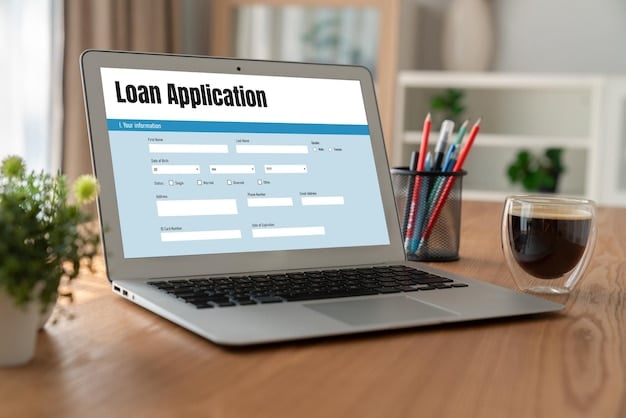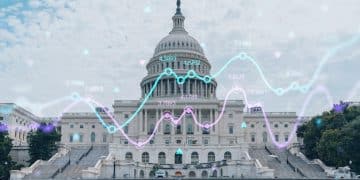Student Loan Forgiveness 2025: Understanding the Latest Changes

Anúncios
Understanding the latest changes to student loan forgiveness programs in 2025 involves navigating complex eligibility requirements, application processes, and potential program adjustments that impact millions of borrowers in the United States.
Navigating the world of student loans can feel like a never-ending maze, especially with constant policy shifts. Understanding the latest changes to student loan forgiveness programs in 2025 is crucial for borrowers seeking relief and clarity. Let’s break down what you need to know to stay informed and potentially benefit from these evolving programs.
Anúncios
The Current Landscape of Student Loan Forgiveness
The student loan forgiveness landscape is constantly evolving, influenced by economic conditions, political priorities, and ongoing legal challenges. Understanding the current environment is the first step in navigating potential forgiveness opportunities.
Key Federal Student Loan Forgiveness Programs
Several federal programs offer pathways to student loan forgiveness, each with its own specific requirements and benefits.
Anúncios
- Public Service Loan Forgiveness (PSLF): For those employed by government organizations or qualifying non-profits.
- Income-Driven Repayment (IDR) Forgiveness: Available after a certain number of years of qualifying payments under an IDR plan.
- Teacher Loan Forgiveness: Specific to teachers who serve in low-income schools for a designated period.
Staying up-to-date with these programs is essential, as eligibility criteria and application processes may change.

The Biden-Harris Administration has made several attempts to expand student loan forgiveness, but these efforts have faced legal challenges and varying degrees of success.
Proposed Changes and Their Potential Impact
Looking ahead to 2025, several proposed changes to student loan forgiveness programs may significantly impact borrowers. It’s important to stay informed about these potential shifts and how they might affect your repayment strategy.
Expansion of Income-Driven Repayment Plans
One potential change involves expanding access to and benefits within income-driven repayment (IDR) plans. This could include lower monthly payments, faster forgiveness timelines, and more favorable interest accrual rules.
- Revised Eligibility Criteria: Making IDR plans accessible to a broader range of borrowers, regardless of income level.
- Simplified Application Process: Streamlining the application process to reduce paperwork and administrative burdens.
- Increased Forgiveness Amounts: Raising the maximum amount of loan debt that can be forgiven under IDR plans.
These changes could make student loan repayment more manageable and attainable for many borrowers.
Another significant development is ongoing discussions regarding the cancellation of student debt. While large-scale forgiveness initiatives have faced legal obstacles, targeted approaches, such as forgiving debt for borrowers with specific circumstances (e.g., borrowers with disabilities or those who attended predatory institutions), remain a possibility.
Navigating the Application Process in 2025
Applying for student loan forgiveness can be complex, but understanding the process and gathering the necessary documentation can increase your chances of success.
Essential Steps for Application
Whether you’re applying for PSLF, IDR forgiveness, or another program, certain steps are crucial.
- Research Eligibility Requirements: Ensure you meet all criteria for the specific program you’re applying for.
- Gather Required Documentation: Collect all necessary paperwork, such as employment verification forms, income statements, and loan documents.
- Submit a Complete Application: Follow the application instructions carefully and ensure all information is accurate and up-to-date.

The Department of Education’s website provides detailed information about student loan forgiveness programs, including eligibility criteria, application instructions, and contact information for loan servicers.
Potential Challenges and How to Overcome Them
Applying for student loan forgiveness isn’t always smooth sailing. Borrowers may encounter challenges such as complicated paperwork, unclear eligibility requirements, and bureaucratic delays.
Common Obstacles and Solutions
Understanding these challenges and developing strategies to overcome them can improve your chances of success.
- Unclear Eligibility Requirements: Consult with a student loan advisor or attorney to clarify any ambiguities in the eligibility criteria.
- Complicated Paperwork: Seek assistance from your loan servicer or a non-profit organization that provides free or low-cost student loan counseling.
- Bureaucratic Delays: Keep detailed records of all communication with your loan servicer and follow up regularly to check the status of your application.
Persistence and proactive communication are key to navigating potential roadblocks in the application process.
Expert Tips for Maximizing Forgiveness Opportunities
Beyond the basics, there are several strategies borrowers can employ to maximize their chances of receiving student loan forgiveness.
Smart Strategies for Borrowers
Consider these tips to optimize your loan repayment plan and forgiveness opportunities.
- Choose the Right Repayment Plan: Select a repayment plan that aligns with your financial goals and eligibility for forgiveness programs.
- Consolidate Your Loans: Consolidating federal student loans can simplify repayment and make you eligible for certain forgiveness programs.
- Stay in Contact with Your Loan Servicer: Maintain open communication with your loan servicer to stay informed about program updates and potential opportunities.
Working closely with a financial advisor or student loan counselor can help you develop a personalized strategy that maximizes your chances of receiving forgiveness.
Resources for Staying Informed
Staying informed about the latest changes to student loan forgiveness programs is essential for borrowers. Several resources can help you stay up-to-date.
Reliable Sources of Information
Refer to these sources for accurate and timely information.
- Department of Education Website: The official source for information about federal student loan programs.
- Consumer Financial Protection Bureau (CFPB): Provides resources and education about student loans and other financial products.
- Non-Profit Organizations: Many non-profit organizations offer free or low-cost student loan counseling and resources.
By actively seeking out information and staying informed, borrowers can make the most of available forgiveness opportunities and manage their student loan debt effectively.
In conclusion, the latest changes to student loan forgiveness programs in 2025 present both challenges and opportunities for borrowers aiming to alleviate their financial burdens. By becoming adept at understanding ever-evolving eligibility criteria, application processes, and potential program adjustments, borrowers can more successfully navigate their path toward debt relief. Furthermore, by closely monitoring legislative updates and potential policy shifts, borrowers can dynamically adjust their repayment strategies to best suit their needs and circumstances. Proactive engagement with resources offered by government agencies and non-profit organizations ensures borrowers remain well-informed, and expert financial advice from counselors can tailor strategies to maximize opportunities. In such a dynamic landscape, informed borrowers are better positioned to secure their financial futures through strategic management of their student loans within the evolving framework of forgiveness programs.
| Key Point | Brief Description |
|---|---|
| 🎉 PSLF Updates | Changes to Public Service Loan Forgiveness eligibility and process. |
| 💼 Income-Driven Repayment | Potential expansion and simplifications to IDR plans. |
| 📝 Application Process | Key steps and required documentation for loan forgiveness. |
| 💡 Maximizing Opportunities | Expert tips for improving chances of loan forgiveness. |
Frequently Asked Questions
▼
The primary programs include Public Service Loan Forgiveness (PSLF) for public sector employees, Income-Driven Repayment (IDR) forgiveness after a set number of payments, and Teacher Loan Forgiveness for eligible educators.
▼
Potential changes include more inclusive eligibility, simpler application processes, and higher amounts of loan debt eligible for forgiveness under revised IDR plans.
▼
Key steps involve researching requirements, gathering necessary documentation like income statements, and submitting a comprehensive and accurate application form.
▼
Challenges may include confusing paperwork, uncertain eligibility criteria, and long processing times. Consulting with a loan advisor or non-profit can help in clarifying these hurdles.
▼
Refer to the Department of Education website, the CFPB, and non-profit organizations for reliable, up-to-date information, resources, and student loan counseling.
Conclusion
Staying informed about the evolving changes to student loan forgiveness programs in 2025 is paramount. By understanding potential alterations, preparing diligently, and seeking expert advice, borrowers can maximize their opportunities for debt relief and secure their financial well-being.





